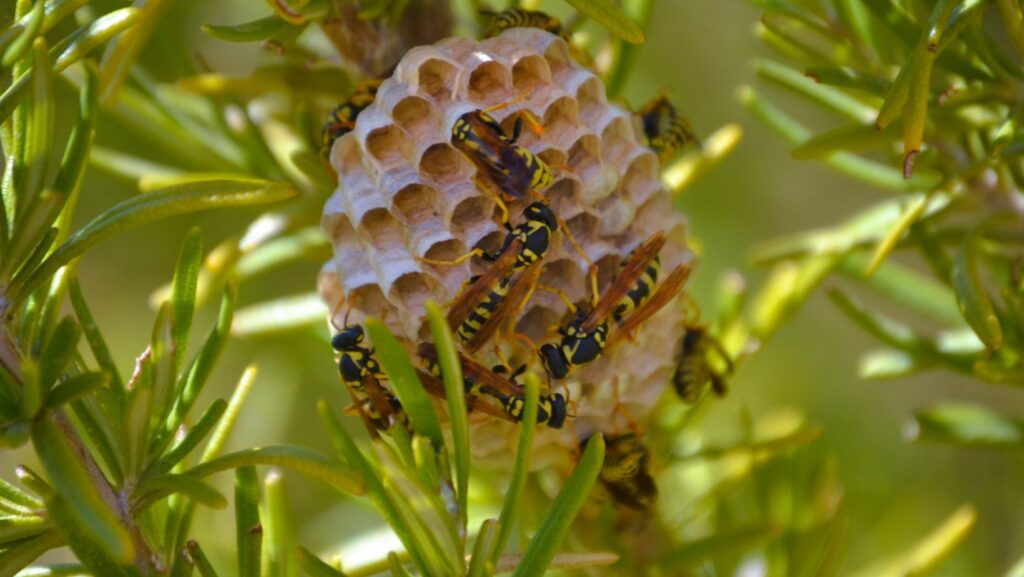Discovering a wasp nest or beehive on your property may incite trepidation; however, it is imperative to approach the situation with care and accountability. Beyond posing potential safety threats, these nests are integral in pollination processes, an essential role for their stinging inhabitants. Consider these top strategies for confronting these insects safely yet efficiently.
1. Identify the Insect Species
Before you take any action, accurately identify whether the insects in question are wasps or bees; this is of paramount importance. Notably–bees serve as critical pollinators and typically exhibit less aggression than their wasp counterparts. Should uncertainty persist, we recommend consulting either a local beekeeping association or a pest control professional for definitive identification.
2. Keep a Safe Distance
To ensure your safety, it is essential that you maintain a prudent distance from the nest or beehive. Bees and wasps exhibit strong protective tendencies towards their colonies; they may escalate to aggression if they perceive any form of threat. Therefore, as a precautionary measure, remain composed, move with deliberate slowness, and circumvent actions such as sudden movements or loud noises that could potentially provoke them.
3. Observe Behavior Patterns
Observe the behavior of insects: typically, bees exhibit a docile nature unless they are provoked; however, wasps can be aggressive and territorial. Should you detect swarming or an escalation in their activity – exercise heightened caution.
4. Wear Protective Clothing
To handle wasp nests or beehives, one must don protective clothing: long sleeves; pants; closed shoes–and gloves.
For enhanced safety, contemplate the utilization of a beekeeping suit or even an advanced-grade wasp suit.
5. Choose the Right Time
Choose to remove during the evening or early morning when the insects display reduced activity. During these times, bees and wasps exhibit less aggression as they usually keep most of their colony in the nest. Avoid trying to remove them at peak activity during the day.
6. Use Natural Repellents
Citrus peels, cucumber slices, or a mixture of water and essential oils such as peppermint or eucalyptus—these natural repellents possess the ability to deter bees and wasps. Indeed, when strategically placed in an area—they serve as effective deterrents against these potentially harmful insects.
7. Do Not Disturb the Nest or Hive
Unless you possess the essential experience and equipment, refrain from any attempts to remove or disrupt the nest or beehive on your own. Provoking an aggressive response by disturbing the colony could result in stings and potential allergic reactions.
8. Seek Professional Assistance
Should the nest or beehive perch in a precarious location, posing potential threat to human safety: or if handling this situation is something you’re unsure of – it’s prudent to seek professional assistance. Local pest control companies and beekeepers: they are specifically equipped for safe management of these scenarios.
9. Consider Relocation for Bees
Should you encounter a non-immediate threat from a beehive, it is advisable to contact a local beekeeper; numerous beekeepers demonstrate their willingness not just exterminate these colonies – but rather relocate them. Such actions significantly contribute towards the conservation of essential pollinators: bees.
10. Do Not Use DIY Insecticides
Over-the-counter insecticides or DIY solutions for nest removal should be avoided; these options pose potential health hazards and environmental risks.
Professional pest control services, however, can access specialized–safe and effective–removal methods: an ideal choice in this scenario.
11. Stay Informed about Local Regulations
Before you attempt any removal, acknowledge the local regulations: they dictate guidelines specifically designed to protect pollinators like bee colonies or wasp nests. Violating these rules could incur fines; therefore, exercise caution and ensure compliance with all applicable laws–this is imperative.
12. After Removal, Secure Entry Points
After successfully removing the nest or beehive, implement preventive measures: secure all potential entry points to circumvent future infestations–seal cracks, crevices and openings in walls; roofs; or eaves where these insects might construct their nests.
To conclude, addressing wasp nests and beehives demands a blend of caution and knowledge—indeed, responsible action is indispensable. Safety must receive primacy–there can be no compromise on this front. Equally critical, however, is acknowledging the ecological import of bees: their contribution to our environment cannot be understated. In cases where uncertainty arises—seek professional assistance; it guarantees not only humans’ well-being but also that of these vital pollinators during the removal process –a necessary step towards preservation indeed!




More Stories
Comprehensive Dental Care for a Healthy, Confident Smile
The Hidden Benefits of Upgrading Your Windows: Beyond Energy Efficiency
The Business of Casinos and Lottery Systems: A Unique Perspective